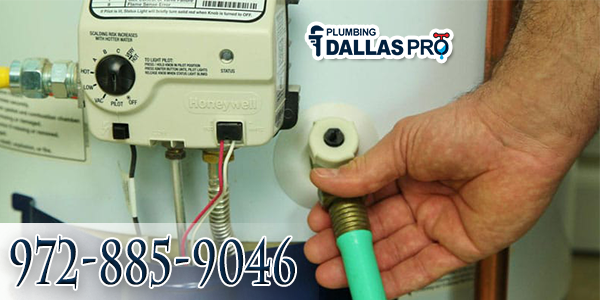
How to Flush a Water Heater ?

Need help ? Watch this quick video
Step 1
Locate the electrical heater breaker / fuse box or gas heater thermostat. You will need to first find the main power source and shut it off before you start draining your water heater.
- Usually a small, gray control panel (about the size of a shoebox) with a swinging door is the breaker box or fuse box. Often it is connected to a wall. It is found in the garage in some homes and may be on the outside of the house in others.
- The gas heater thermostat is normally a red knob on the outside of the heater where the gas pipe is inserted into the device. The settings of the knob should be 3: "Pilot," "On," and "Off."
Step 2
Disable the circuit or fuse running the electric water heater or switch the thermostat on a gas heater to "Pilot." This will stop the water heater or the whole building, depending on which circuit / fuse you disable.
- Small on / off switches should be seen. These are called "branch circuit breakers," providing protection against electrical overload to different circuits that power your home. If you know your water heater is operated by the branch circuit breaker, turn off this person.
- If you don't know which circuit breaker drives your heater, locate a larger "Main" switch above the circuit breaker. Lower amperage values such as 100, 150, and 200 must be used by the main circuit breaker. The branch circuit breakers will have 10-60amps lower numbers. Switch off the main power, but that for the time-being all the electricity in your house will be shut down.
- You have a fuse box, not a breaker box, if you open the box and find square, glass covered shapes or narrow tubes with metal ends.[2 ] In this situation, you will need to unwind and disconnect the fuse to controls your water heater (similar to switching off the circuit breaker of the branch). Look for a large rectangular box with a handle / lever at the top of the panel if you are unsure of which fuse to cut. Tug the handle hard and flat, but be careful because the metal parts may be hot.[3 ] The electricity for your entire house has now been shut down.
Step 3
Switch off your supply of cold water by turning the clockwise heat shut-off valve. At or near the cold water inlet tube at the top of the tank, the shut-off valve should be mounted.
- Two types of valves are in use: ball valves and valves for the window. The ball valve is closed and opened by a 90-degree switch, but a gate valve takes a lot of turns.
- Many gate valves have a "delay" before being completely closed or opened, so be sure to turn the valve past that stop. It is possible to leave on gas and propane supply valves for non-electric heaters.
- Take a note of the temperature setting for natural gas and propane water heaters and then switch the thermostat, the large red dial at the front of the screen, to the lowest setting, or "Pilot."
- When you intend to use the water for other purposes, turn off the heat in advance and allow the water to cool before draining overnight.
Step 4
Open the faucet with hot water in the sink or tub. This prevents the formation of a vacuum in the lines that keeps water trapped.
- A common example is when you cover the top of a straw for liquid retention.
Step 5
Connect a garden hose, at the bottom of the radiator, to the drain cock or lock. Normally, the drain cock looks like a regular hose bib, like a garden faucet, or a round dial in the middle with a threaded hole.
- Under a transparent mask, the drain cock may be covered.
- You can use a bucket to collect the water and manually drain it somewhere dry if you don't have a garden hose. Don't overfill the bucket as hot water can soften or burn cheaper plastic buckets.
Step 6
Extend the garden hose to a position where it is safe to discharge the water from the heater. Just run your hose to a drain on the outside or on the driveway.
- If you let the water cool overnight, you can dump it into buckets and save the heat to be used on the yard or for other purposes. Due to the presence of sand, do not use it for delicate plants, however, or wash your car.
- Also be mindful about the products you are using when removing hot water. Because of the water, low-quality hoses and buckets could soften and cause leaks. Drain straight into a suitable basement drain or sump hole to simplify the process.
- Cover the drain cock and hose link with a towel or rag to prevent the bursting and spraying of scorching water in the event of a pressure leak, especially if the water heater supplies a second floor or if it is located in a basement.
Step 7
To allow water to escape the heater, open the drain cock. Consider opening the pressure-relief valve to allow water to flow freely, usually at the top of the unit. Nonetheless, do NOT open the pressure relief valve without placing a bucket under the discharge tube first. Unless something is put under the discharge pipe to catch the water, opening it can cause water to drain onto the ground.
- Normally, the pressure relief valve is a lever that you turn to the "right" position to open it.
- Make sure the water flows at a pace that can be controlled everywhere you drain.
- Caution: It will be extremely hot as it exits the tank if you did not allow the water to cool. Realize as well that if the drain cock is made of plastic and the heater is several years old, it can be hard to open and break when forced.
Step 8
After a few minutes of flushing, fill a "check" bucket with the still flowing water. Let the water in the bucket sit for a minute without interference and see if the water is clear or if any sand-like content settles down.
- If the water is muddy or you see sand-like content on the bucket's rim, keep draining the tank until the water is clear (sediment-free or discoloring). If the tank is empty but you suspect that there is still sediment, turn the supply of cold water back on to allow more water to enter the unit. Partly fill the tank and empty it again. Repeat this process until there is a complete discharge.
- If the water is clear and you don't see any sand, then you can go on to the next stage.
Step 9
Open the cock drain and remove the hose from the garden. When opened, open the stress relief valve.
- Always remember to shut off your sink or tub's hot water faucet
Step 10
Switch on the water supply and fill the tank. Slowly reopen the pressure relief valve to drain off the excess air when the tank is full and the pressure has equalized.
- This will avoid "pinging" of the water heater when cold water re-enters it during daily usage. The pressure relief valve is closed again after all the compressed air has escaped.
Step 11
Close the drain for the water heater. Open the bathroom's hot water tap to bleed moisture.
- Do not turn on the control yet. If you turn on the power without filling, it can damage the heating element. Wait for a full stream of water and open the hot water tap on the tub or wash basin.
Step 12
Turn the water supply back on and wait for the continuous running of the hot water pipe. After the full volume of the hot water tap is working, switching on the circuit breaker or fuse box is free.
Step 13
Switch off the spigot for the tub. Wait approximately 20 minutes and then check at the tub for warm water.
- To decide if it is working, listen closely to the water heater.



© Copyright 2015-2019 www.plumbingdallastxpro.com